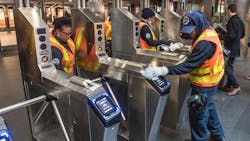Best Practices in the Sterilization of Transit Property
At this point, it’s common knowledge that the COVID-19 virus is spread through person-to-person contact. But there is also compelling evidence that suggests the virus can remain active for hours ̶ even days ̶ on some types of surfaces. And this a problem, especially for the transit industry.
Case in point: The New England Journal of Medicine just released a report that investigated claims as to long the virus can remain viable on different kinds of surfaces. Their analysis revealed that COVID-19:
“Was more stable on plastic and stainless steel than on copper and cardboard, and viable virus was detected up to 72 hours after application to these surfaces. But it’s important to note that the amount of virus decreased rapidly over time on each of those surfaces. And so, the risk of infection from touching them would probably decrease over time as well1.”
Some may interpret this as ‘good news’, but I don’t! The mere fact that COVID-19 is so virulent makes the cleaning and disinfecting of every mode of transport ̶ be it train, plane, bus, taxi, or subway, etc. ̶ an important part of any program designed to fight the virus. And, while it’s true that your passengers are more likely to be infected by person-to-person interaction than by coming into contact with a contaminated surface, it’s worth noting that “80% of bacteria are transmitted by hands and 76 out of 100 people either don't wash their hands at all or don't use soap2.”
It should come as no surprise then that New York’s Metropolitan Transportation Authority (MTA) announced3 that all of its trains, buses, and other modes of public transports will be sanitized every 72 hours. Plus, they are going to disinfect often-touched surfaces in stations every day. San Francisco's Bay Area Rapid Transit (BART) system also intends to implement similar practices on its vehicles and in stations and bus terminals.
A Daily Sterilization Checklist
I say ‘daily’ checklist because it is often impractical to clean often-used vehicles more than once a day, even if you have reduced ridership. It takes about three hours to completely clean a city bus, according to the MTA. But they have 1,000 buses on the roads ̶ to say nothing of their immense subway system and suburban rail services ̶ so you can immediately see how daunting a task this can be.
Still, it has to be done, one way or another.
As such, transportation organizations and bus companies, as well as ride-share businesses and airlines, etc, need to have ‘to-do’ checklists in place so that every single cleaning assignment can be tracked and proper records kept.
Among the tasks a company or organization should accomplish:
1. Cleaning and disinfecting surfaces (and objects) that are often touched.
- On trains you should see to doors, handrails, seat head rests, seats themselves, floors, and windows; plus, in the bathrooms, doorknobs, lights switches, sink handles, toilets, toilet handles, mirrors, sinks and soap dispensers.
- On planes, the same objects should be cleaned, as well as carpeting, headphone sets, tray tables, over-head compartments, etc.
- On buses, ceilings, windows, window ledges, walls and floors should be wiped down with cleaning agents and disinfectants. Upholstered seats should be vacuumed, and damaged seats replaced. You should include stanchions, entry/exit-way grab rails, pull cords stop buttons, the top of the farebox and the driver’s area.
2. Cleaning all shared equipment ̶ several times a day ̶ and again at the end of work assignments.
3. Using the appropriate household cleaners and, even better, EPA-approved disinfectants that are effective against the COVID-19 virus. Note: be sure to follow the instructions on the labels of these products.
4. Ensuring that you have adequate personnel to accomplish all the tasks on your check list. Note: you may be forced to hire additional staff to cover your increased workload, as well as temporarily replacing workers who are sick or self-quarantining.
Getting Your Staff on Board
For those organizations and companies fortunate enough to either have their own, dedicated cleaning staff or an outside firm that offers the same service on a contract basis, much of what we’ve said will be ‘old news’, although it’s always good to refresh the collective memory.
Still, for operations that cannot justify the cost of such guaranteed assistance, the onus falls on them to bring the same level of cleanliness and hygiene to their operations as the bigger folks. And by the way, this isn’t just a purely desirable goal. It’s a business imperative! Not being conscientious and committed to a thorough cleaning regimen can be a recipe for disaster! The reputation you spent years building can disappear overnight if your vehicles become known for their lack of hygiene, or, to put it bluntly, being downright dirty.
That’s why it’s important that all your employees ‒ be they drivers, conductors, flight attendants, pilots, train crews, baggage handlers, ticket agents, courtesy personnel and so forth ‒ are aware of the importance of cleanliness ̶ and immediately report any problems they encounter. And, if you have to, remind them that it’s not just their health that’s on the line, but their jobs too.
Choosing and Handling Disinfectants
There are literally hundreds of effective disinfectants on the market, which can make it hard to know what to select. Whichever disinfectant you decide to use for your vehicles, it’s extremely important that your staff know how to store and handle these materials. A useful source of information comes from yet another federal agency: The Occupational Safety and Health Administration (OSHA) provides useful safety advice5 regarding the safe handling of disinfectants.
And Not Forgetting . . .
In the rush to clean and disinfect vehicles, however, there’s a better than even chance that some folks will forget ̶ and in certain cases, ignore ̶ some transportation facilities, such as bus and train stations, waiting rooms, ticketing areas, and the conveniences they offer: Public seating, toilets and bathrooms, on-site retail stores, fast-food outlets (e.g. McDonald’s, Starbucks, Pizza Hut, Dunkin Donuts, etc.), gift shops, elevators and escalators and so on.
The problem is that any one these facilities can become a COVID-19 hotspot.
For example, New York’s Penn Station handles some 650,000 passengers every day, while the MTA provides subway services6 for 5,437,587 riders operating out of 472 stations. And practically everything in their facilities ̶ including stations and high-touch surfaces such as turnstiles, ticket machines, handrails, and so forth — have to be thoroughly cleaned at least once a day, more if possible.
All of this makes life more difficult for everyone, but these cleaning protocols are simply unavoidable ̶ if we are to be safe.
If you need information about any of the topics in this article, I suggest you consult one, or all, of these US sources:
- Centers for Disease Control and Prevention
- Department of Health & Human Services
- Environmental Protection Agency
- National Institute for Occupational Safety and Health
- American Medical Association
Good luck, and stay well!
--------------------------------------------
Footnotes - Neeltje van Doremalen, Trenton Bushmaker, Dylan H. Morris, Aerosol and Surface Stability of SARS-CoV-2 as Compared with SARS-CoV-1, New England Journal of Medicine, March 2020. https://www.nejm.org/doi/full/10.1056/NEJMc2004973?query=featured_home
- ibid.
- MTA Issues Agency-Wide Update on Precautionary Measures Against Coronavirus, MTA Press Releases, March 2020. http://www.mta.info/press-release/mta-headquarters/mta-issues-agency-wide-update-precautionary-measures-against
- Disinfectants for Use Against SARS-CoV-2, Pesticide Registration, Environmental Protection Agency, March 2020. https://www.epa.gov/pesticide-registration/list-n-disinfectants-use-against-sars-cov-2
- Richard E. Fairfax, OSHA's policy regarding the use of EPA-registered disinfectant, Standard Interpretations, Occupational Safety and Health Administration, February 2005. https://www.osha.gov/laws-regs/standardinterpretations/1999-07-15
- Introduction to Subway Ridership, Metropolitan Transportation Authority, 2020. http://web.mta.info/nyct/facts/ridership/
About the Author

Noel McCarthy
Staff writer, Steri-Fab
Noel McCarthy has worked as a writer and editor throughout his career. A former director for Thomson Reuters, Noel also worked for PwC for 17 years. A staff writer for Sterifab, Noel's expertise in pesticides and disinfectants is a newfound hobby of sorts. He has enjoyed learning about these pesky little pests, and their entourage of friends including lice, mites and more.

